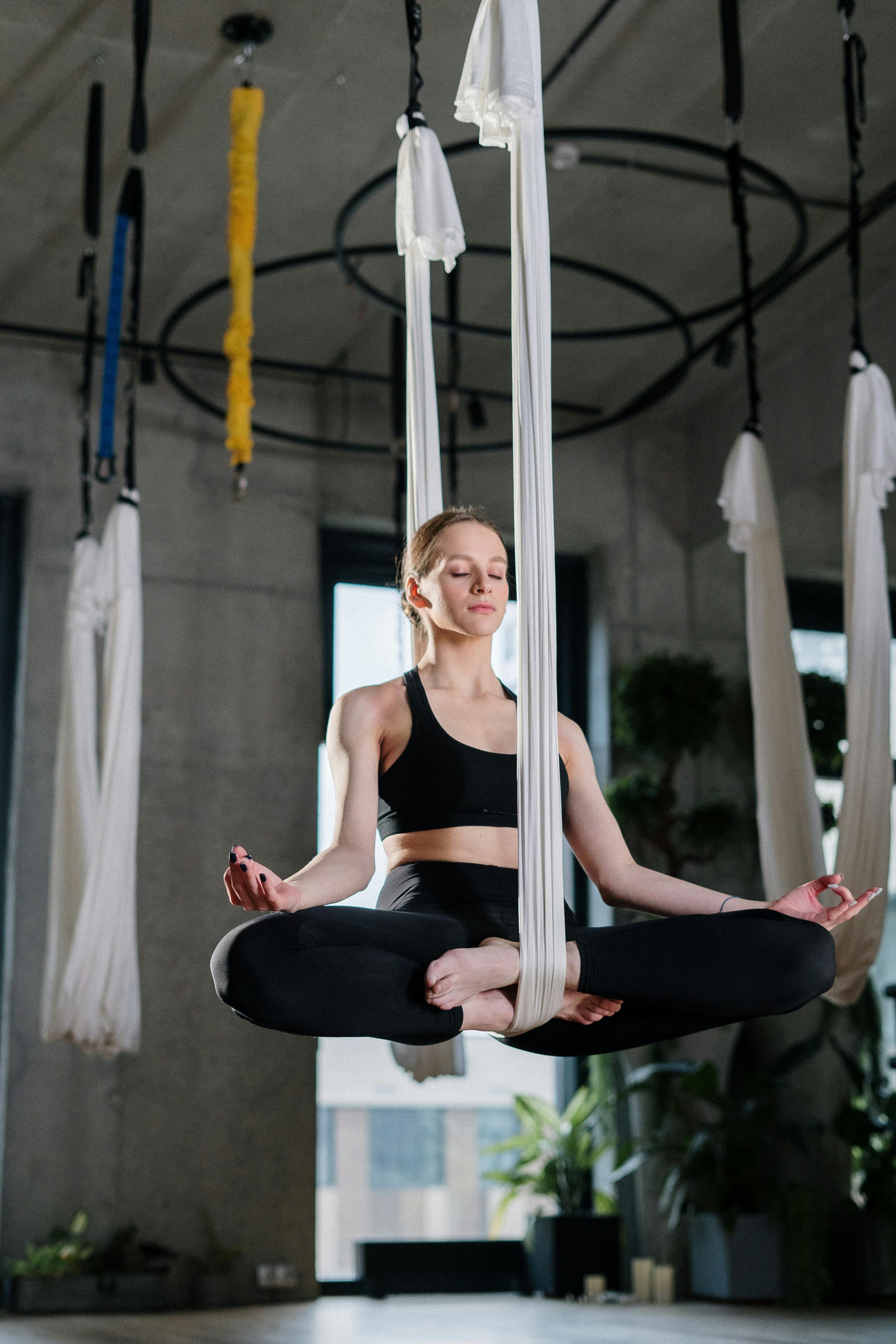Aerial Fitness: Guide, Advantages, precautions, and Insights
Fly High with Aerial Yoga: A Daring Way to Strengthen Your Body and Mind
Embrace the thrill of aerial arts by delving into the world of aerial yoga! This exhilarating practice merges traditional yoga techniques with the allure of aerial acrobatics, using a hammock to perform poses in mid-air.
Whether you dream of soaring through the skies like a superhero or long for a fresh change in your fitness routine, aerial yoga offers an unparalleled opportunity to push your physical and mental limits. It's not just about nailing difficult poses; it's also about boosting confidence and fostering body positivity.
Eager to take off? Here's a crash course on getting started, and a rundown of the perks and potential pitfalls of this exciting new practice.
What is Aerial Yoga?
Aerial yoga is essentially a yoga class where, instead of sticking to your mat, you'll find yourself dangling from a silk hammock that's suspended from the ceiling. This unique setup allows you to sink deeper into each pose, building strength and improving flexibility in ways that traditional yoga can't. And if you're intrigued by more challenging poses, the hammock serves as an impressive prop to help lighten the load on your head, shoulders, and spine.
Don't be deterred by the initial appeal of aerial yoga—fear not, as beginner-friendly classes are designed to help you learn the ropes (literally) and get comfortable with the setup, even if you might feel like a dancer from Moulin Rouge! Some fitness studios might refer to aerial yoga as "aerial fitness" or "anti-gravity fitness."
Unlock the Benefits of Aerial Yoga
Yoga provides a remarkable range of benefits for both the body and mind, and an aerial yoga practice can help:
- Enhance breath awareness
- Tone and strengthen the core
- Trigger the release of mood-boosting endorphins
- Boost flexibility
- Improve strength
- Enhance the mind-body connection
- Release tension in muscles, joints, and the spine
Soar through an Aerial Yoga Class
The structure of aerial yoga classes can vary, but they generally follow a similar pattern:
Certified aerial yoga instructor, Jennifer Ramey, shares that she begins her classes with a warm-up, followed by conditioning, a flow, and at least one inversion. Ramey adds, "We work one-on-one with students to develop confidence and creativity in their practice. We end with a cooldown and grounding, and you will leave feeling relaxed and strong."
Don't expect an instant flight on day one—your inaugural aerial yoga class will likely focus on covering equipment basics and helping you feel comfortable working alongside your instructor. "We primarily work with clients on developing a safe practice that can grow in time by starting with a strong foundation in basics," says Ramey.
Aerial Yoga vs. Traditional Yoga
While traditional yoga provides a multitude of benefits for overall health and well-being, aerial yoga introduces a unique set of advantages, primarily due to its incorporation of aerial elements.
"[Aerial yoga] is a unique training concept that fuses strength, agility, and balance in a thrilling and confidence-building way," says Ramey.
While classic yoga keeps you grounded on your mat, aerial yoga provides you with the opportunity to use suspended fabrics to extend and enhance certain poses, thereby increasing the challenge and boosting your skills more quickly than typical mat-based yoga.
"The movement of the fabrics provides the student with unique variations of traditional movements," says Ramey. "We are able to suspend within the fabrics and invert, which is fantastic for blood flow, joint pressure, and spinal alignment."
Can You Practice Aerial Yoga at Home?
Technically, yes, you can practice aerial yoga at home. However, Jennifer Ramey advises against attempting solo aerial yoga without extensive experience handling the equipment.
If you want to practice aerial yoga at home, Ramey recommends consulting a professional rigger to set up a safe base in your ceiling or overhead beam. Once the setup is secure, collaborate with an aerial yoga pro to find reputable brands and specialized companies dealing in aerial arts.
"Do not purchase from Amazon or anywhere not specializing in the aerial arts—not all equipment is created equally," warns Ramey. "Quality equipment is not an area you want to be stingy with."
Tips for Aerial Yoga Beginners
Ready for liftoff? Here are some pointers to help you soar:
- Find the perfect studio that caters to your needs. Some yoga studios don't offer aerial classes. Elsewhere, you can consult with your favorite yoga instructor for recommendations.
- Don a suitable outfit. Tighter clothing is ideal for aerial yoga, as loose or baggy clothes might leave you feeling exposed when you're inverted. Long-sleeved shirts can also help prevent chafing.
- Persistence pays off! Aerial yoga might feel unusual the first time around, considering you're doing yoga in mid-air. But keep practicing and remember—patience is key!
- Embrace your situation! You don't need to be in peak physical condition or possess impressive upper-body strength to start practicing aerial yoga. Beginner classes will help you build strength and stamina gradually.
- Come prepared! Bring water, an open mind, and a willingness to trust your instructors and their movement style.
Risks Associated with Aerial Yoga
As with any physical activity, aerial yoga poses some risks:
- Falls can happen if the equipment is not secure or if the student loses control.
- Injuries can arise from overstretching or improper technique.
- Aerial yoga involves inversions and hanging poses that may put extra stress on the joints if not executed correctly.
tl;dr
Aerial yoga provides a captivating and invigorating way to de-stress, build strength, increase flexibility, and bolster your mind-body connection. This thrilling practice is also known for boosting confidence and promoting body positivity.
Practicing aerial yoga involves several safety precautions and potential risks that can be mitigated by following the guidance of a certified instructor, using proper equipment, and adhering to all safety guidelines provided by the studio.
Always consult a healthcare professional before engaging in aerial yoga if you are pregnant or if you have a heart condition, blood pressure concerns, or an eye condition.
- Despite the initial appeal of aerial yoga, it's essential to learn the basics and feel comfortable with the setup, even if you might feel like a beginner.
- The hammock used in aerial yoga serves as an impressive prop, helping perform challenging poses that traditional yoga might not offer, boosting strength and flexibility.
- Aerial yoga comes with added risks, like falls, injuries from overstretching or improper technique, and stress on joints from inversions and hanging poses, but these can be mitigated by following safety precautions and a certified instructor's guidance.






